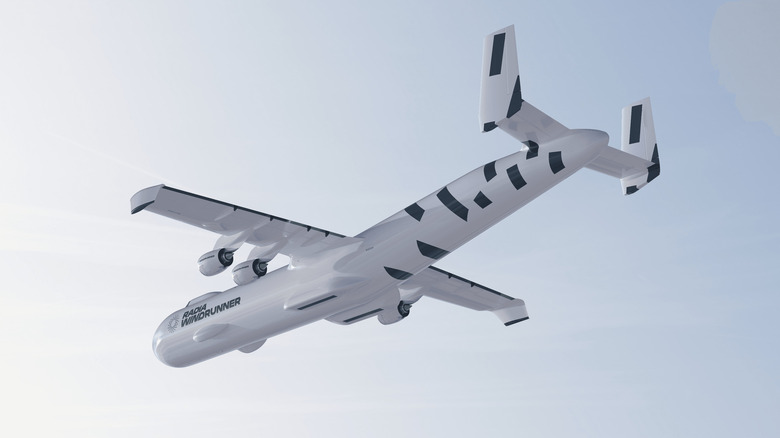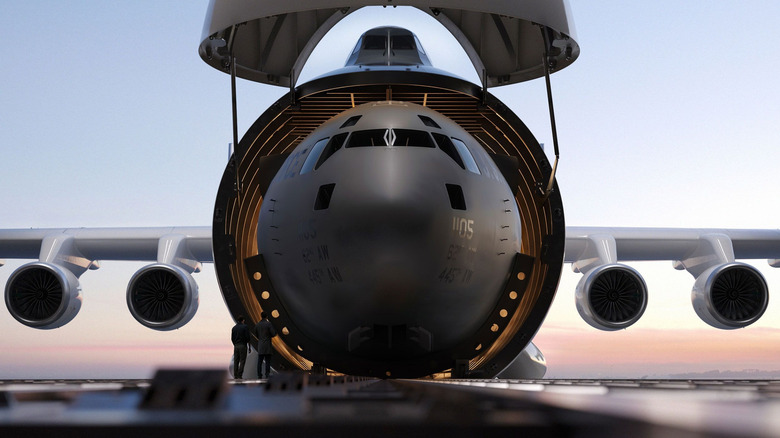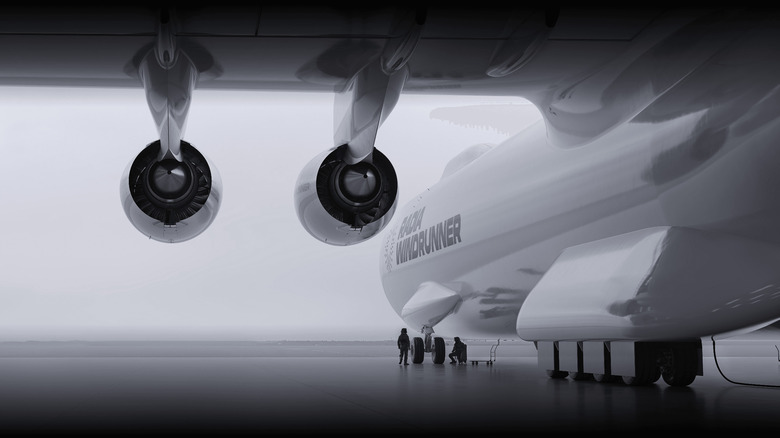The Largest Military Aircraft Ever Will Be Big Enough To Transport Fighter & Helicopter Squadrons
Airplanes grew rapidly in size after the dawn of the aviation age in the early 20th Century. Howard Hughes' incredible Spruce Goose was a 218 foot long behemoth that only took the air once, but this engineering failure hasn't stopped plane manufacturers from trying to go even bigger. The Lockheed-Martin C-5M Super Galaxy is America's biggest military jet at just under 248 feet long; it can carry up to 281,000 pounds of weaponry, personnel, and cargo. The C-5 is getting a little oudated, so defense start-up Radia is developing the WindRunner, an even bigger plane that will be suitable for military or commercial use. Existing large cargo planes like the C-5, C-17 Globemaster III, and Airbus A400M Atlas can haul helicopters, trucks, and jets, but these vehicles often must be partially disassembled to fit in cargo holds. Doing this and re-assembling them at the destination takes time and effort, so Radia hopes to eliminate these costs for many WindRunner buyers.
The WindRunner will have a cargo bay that's 105 meters (344 feet, 6 inches) long and 10 meters (33 feet) wide. Imagine a nine-lane bowling alley that stretches longer than a football field; you could build such a facility inside the WIndRunner. The WindRunner will be impressive in flight as well, with a fully-loaded top speed of Mach 0.6 (over 460 mph) and the ability to land on unpaved runways as short as 1,800 meters (5,906 feet). After the WindRunner touches down, fully assembled equipment can be offloaded through the massive cargo doors. This will allow military forces to quickly deploy heavy helicopters, tanks, and 5th-generation fighters closer to the front lines.
Radia WindRunner possible uses
Radia unveiled its plans for the WindRunner at the Air and Space Forces Association's Air, Space, and Cyber conference in September 2025. The manufacturer claims it will have approximately seven times the cargo volume of a C-5 and 12 times that of the C-17. It should be able to carry six Boeing CH-47 Chinook helicopters without the need for rotor disassembly; that's enough battle-ready aircraft to carry more than 200 fully-geared combat troops. In comparison, a C-17 can only carry two Chinooks at once, greatly increasing fuel consumption and risk to personnel during transport to forward theaters. Other potential loads for the WindRunner include four CV-22 Ospreys, F-16 Fighting Falcons, or F-35C Lightning IIs. The Windrunner's capacity and 1,200-mile range without refueling make it a significant force multiplier, and Radia claims that crew endurance is the only limit to the WIndRunner's range if it's refueled in the air. The WindRunner will also be able to carry booster rockets for the Space Force, saving lots of time versus ground transportation. It won't require special loading equipment for many ground vehicles, as tanks and trucks can be driven on and off the plane through the giant loading doors.
Radia is marketing the WindRunner heavily to the green energy sector, specifically for transporting long wind turbine blades. One possible implementation is to locate planes at hubs where the blades are manufactured or imported. The WindRunner's ability to land on unimproved airstrips means it could take blades directly to remote wind farms, offload them, then return for another batch.
Radia WindRunner specifications
The Radia WindRunner's dimensions aren't its only impressive specs. It will be 109 meters (358 feet) long with a height of 24 meters (79 feet) and a wingspan of 80 meters (262 feet). Its cargo hold will have a volume of 6,800 cubic meters, which at nearly 1.5 million gallons is more than twice the capacity of an Olympic swimming pool. As another point of illustration, that's enough space for more than 43 million regulation tennis balls.
Don't expect to see the WaveRunner delivering equipment to Wimbledon just yet; as of this writing the aircraft exists only on the drawing board. Radia has yet to unveil a prototype, but hopes to make test flights in the next few years in preparation for production in 2030. It's yet unclear if the United States Department of War (formerly the Department of Defense) is interested in buying from the Boulder, Colorado company that aerospace engineer Mark Lundstrom founded less than a decade ago. If the WindRunner delivers on Radia's promises, though, it could be a game-changer for the nation's military and wind farm builders around the globe.


